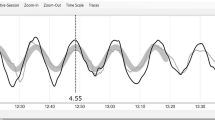Abstract
We present an autoregressive model-based method which enables accurate respiratory rate extraction from pulse oximeter recordings over a wide range: 12–48 breaths/min. The method uses the optimal parameter search (OPS) technique to estimate accurate AR parameters which are then factorized into multiple pole terms. The pole with the highest magnitude is shown to correspond to the respiratory rate. The performance of the proposed method to extract respiratory rate is compared to the widely used Burg algorithm using both simulation examples and pulse oximeter recordings. In a previous study, we demonstrated several nonparametric time–frequency approaches that were more accurate than Burg’s algorithm when the data length was 1 min [Chon, K. H., S. Dash, and K. Ju. IEEE Trans. Biomed. Eng. 56(8):2054–2063, 2009]. One of the key advantages of the AR method is that a shorter data length can be used. Thus, in this study, we reduced the data length to 30 s and applied our OPS algorithm to examine if accurate respiratory rates can be extracted directly from pulse oximeter recordings. It was found that our proposed method’s accuracy was consistently better with smaller variance than Burg’s method. In particular, our proposed method’s accuracy was significantly greater when respiratory rates were lower than 24 breaths/min.






Similar content being viewed by others
References
Ables, J. G. Maximum entropy spectral analysis. Astron. Astrophys. Suppl. 15(1):383–393, 1974.
Burg, J. P. Maximum entropy spectral analysis. In: Proc. 37th Annu. Int. SEG Meet. Oklahoma City, 1967
Chon, K. H., S. Dash, and K. Ju. Estimation of respiratory rate from photoplethysmogram data using time–frequency spectral estimation. IEEE Trans. Biomed. Eng. 56(8):2054–2063, 2009.
Faes, L., G. Nollo, and K. H. Chon. Assessment of Granger causality by nonlinear model identification: application to short-term cardiovascular variability. Ann. Biomed. Eng. 36(3):381–395, 2008.
Fleming, S. G. A Comparison of signal processing techniques for the extraction of breathing rate from the photoplethysmogram. Int. J. Biomed. Sci. 2(1):232–236, 2007.
Lu, S., K. H. Ju, and K. H. Chon. A new algorithm for linear and nonlinear ARMA model parameter estimation using affine geometry. IEEE Trans. Biomed. Eng. 48(10):1116–1124, 2001.
Marple, J. S. L. Digital Spectral Analysis with Applications. Englewood Cliffs, NJ: Prentice-Hall, 1987.
Shelley, K. H., A. A. Awad, R. G. Stout, and D. G. Silverman. The use of joint time frequency analysis to quantify the effect of ventilation on the pulse oximeter waveform. J. Clin. Monit. Comput. 20(2):81–87, 2006.
Trainin, N., M. Burger, and A. M. Kaye. Some characteristics of a thymic humoral factor determined by assay in vivo of DNA synthesis in lymph nodes of thymectomized mice. Biochem. Pharmacol. 16(4):711–720, 1967.
Wang, H., S. Lu, K. Ju, and K. H. Chon. A new approach to closed-loop linear system identification via a vector autoregressive model. Ann. Biomed. Eng. 30(9):1204–1214, 2002.
Wang, H., K. Siu, K. Ju, and K. H. Chon. A high resolution approach to estimating time–frequency spectra and their amplitudes. Ann. Biomed. Eng. 34(2):326–338, 2006.
Xiao, X., Y. Li, and R. Mukkamala. A model order selection criterion with applications to cardio-respiratory-renal systems. IEEE Trans. Biomed. Eng. 52(3):445–453, 2005.
Zou, R., and K. H. Chon. Robust algorithm for estimation of time-varying transfer functions. IEEE Trans. Biomed. Eng. 51(2):219–228, 2004.
Zou, R., H. Wang, and K. H. Chon. A robust time-varying identification algorithm using basis functions. Ann. Biomed. Eng. 31(7):840–853, 2003.
Author information
Authors and Affiliations
Corresponding author
Additional information
Associate Editor Leonidas D. Iasemidis oversaw the review of this article.
Rights and permissions
About this article
Cite this article
Lee, J., Chon, K.H. Respiratory Rate Extraction Via an Autoregressive Model Using the Optimal Parameter Search Criterion. Ann Biomed Eng 38, 3218–3225 (2010). https://doi.org/10.1007/s10439-010-0080-9
Received:
Accepted:
Published:
Issue Date:
DOI: https://doi.org/10.1007/s10439-010-0080-9




